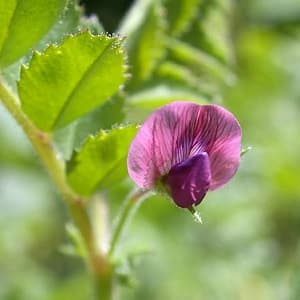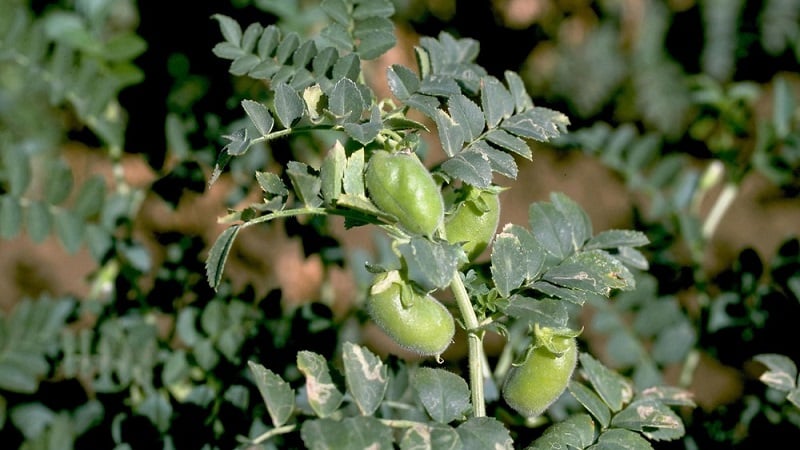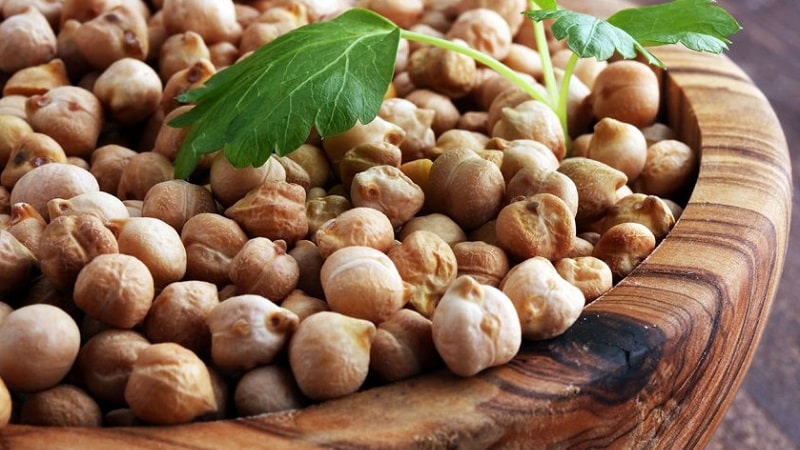Description and characteristics of chickpeas
Turkish peas, or chickpeas, have been known to mankind since ancient times. This leguminous crop, previously known only in Asian and African countries, is now gaining popularity in Russia. Chickpeas and flour are actively used in vegetarian cuisine, and due to their low glycemic index, chickpeas are indispensable for people suffering from diabetes. In the article we will tell you what chickpeas are: legumes or grains, as they look in the photo where they grow.
What are chickpeas
Chickpeas are a large genus of plants in the legume family.. It combines herbaceous and shrubby plants. The most famous of them is chickpeas, or chickpeas, the seeds of which are used for cooking.

Chickpeas are also called the seeds of chickpea beans, from which cereals and flour are prepared.. They are widely used in cooking boiled, fried or baked. Due to its high protein content, chickpeas are popular among vegan and vegetarian dieters. Dishes made from chickpeas are found in the cuisines of many peoples around the world.
Important! There are no differences between Uzbek, Turkish and lamb chickpeas - they are the same plant. Other common names for chickpeas are walnut peas and nochut.
What does the plant look like?
The chickpea is an annual herbaceous plant. with an erect, less often drooping stem, covered with short glandular hairs. The plant reaches a height of 20 to 70 cm. The leaves are odd-pinnate, with elongated oval leaves. One leaf has from 11 to 17 leaflets.
 The flowers are self-pollinating, solitary, typical of leguminous plants., with small toothed stipules. There are 5 petals: the upper one, or sail, two side ones - oars, and two lower ones, fused, called a boat. The petals, depending on the variety, are yellow or various shades of pink - from pale to purple. There are 10 stamens, 1 pistil. The photo shows a chickpea flower.
The flowers are self-pollinating, solitary, typical of leguminous plants., with small toothed stipules. There are 5 petals: the upper one, or sail, two side ones - oars, and two lower ones, fused, called a boat. The petals, depending on the variety, are yellow or various shades of pink - from pale to purple. There are 10 stamens, 1 pistil. The photo shows a chickpea flower.
The fruit is a bean, rhombic, less often oval, yellow or purple. The beans contain 1-3 seeds of a round shape, reminiscent of the head of a ram or an owl. The seeds, depending on the variety, are from light yellow to dark, almost black, with a diameter of 5 to 15 mm. The weight of 1000 seeds ranges from 150-300 g.
The appearance of chickpea varieties varies slightly:
- brown - 45-70 cm high, with red-violet flowers and brown seeds in angular beans;
- yellow – erect, 30-50 cm high, with yellow flowers and yellow-beige seeds;
- red - powerful compact plants up to 30 cm high, resistant to drought and high humidity, seeds of red-brown and terracotta color;
- white – up to 45 cm high, with powerful shoots, pale pink flowers, seeds in round beans, white;
- black - 30-60 cm high, pink flowers, rich dark-colored seeds with a bright spicy smell and pronounced taste.
Chickpea varieties also differ in appearance. In Russia, according to the State Register of Breeding Achievements, 25 chickpea varieties are allowed for cultivation, of which 2 are used as feed for farm animals.

Are they legumes or grains?
From a botanical point of view, chickpeas are a leguminous plant. However from an agricultural point of view, it is both a grain and a legume crop, belonging to a separate group of legumes.The fruits of such plants are collected to use exclusively dry grains. This group also includes pigeon peas, lentils and cow peas.
Reference. The resulting seeds, after passing through all stages of purification, are classified as cereals. Chickpea flour is also obtained from chickpea seeds by grinding.
Where and how it grows in nature
Mutton chickpeas grow in warm, dry regions. Türkiye and Syria are considered to be their homeland (hence the common name Turkish peas). It does not grow in the wild; it is an exclusively cultivated plant, bred by selection methods from chickpea (lat. Cicer reticulatum). It is grown in many countries of the world, the largest share falls on South and Western Asia.
Composition of chickpeas
Chickpea seeds are a food product with high nutritional value.. It is a source of healthy carbohydrates, zinc, folic acid, and polyunsaturated fats. It contains more than 80 useful micro- and macroelements.
Chemical composition and BZHU vary depending on the variety and type of chickpea. In general, it is very rich in both vitamins and chemical elements necessary for the body. In terms of its total composition, Turkish peas are ahead of many grains and legumes.
Important! Chickpea seeds contain lysine, an essential amino acid necessary for the proper functioning of the body.
Calorie content and BZHU
100 g of dried seeds account for 364 kcal. 100 g of boiled products - 127 kcal.

In 100 g of dry chickpea seeds:
- proteins – 19-30 g;
- fat – 6-7 g;
- carbohydrates – 50-60 g.
Per 100 g of boiled cereal:
- proteins – 8-9 g;
- fat – 1-2 g;
- carbohydrates – 18-27 g.
Interesting things on the site:
Chickpeas in cooking, cosmetology and folk medicine
The most popular chickpea varieties - description and characteristics
Vitamins and other substances
Of the fat-soluble vitamins, boiled chickpeas contain: A, beta-carotene, E and K. Water-soluble vitamins C and group B:
 vitamin A – 1 mcg;
vitamin A – 1 mcg;- beta-carotene – 16 mcg;
- vitamin E – 0.4 mg;
- K – 4 mcg;
- C – 1.3 mg;
- B1 – 0.1 mg;
- B2 – 0.1 mg;
- B3 – 0.5 mg;
- B4 – 42.8 mg;
- B5 – 0.3 mg;
- B6 – 0.1 mg;
- B9 – 172 mcg.
The mineral composition of boiled chickpeas is as follows:
- potassium – 291 mg;
- phosphorus – 168 mg;
- calcium – 49 mg;
- magnesium – 48 mg;
- sodium – 7 mg;
- iron – 2.9 mg;
- zinc – 1.5 mg;
- manganese – 1 mg;
- copper – 0.4 mg;
- selenium – 3.7 mcg.
Amino acids:
- methionine – 3.11 g;
- tryptophan – 1.10 g;
- lysine – 7.65 g;
- isoleucine – 6.81 g.
Conclusion
Chickpeas are a leguminous crop widely cultivated in Asian countries. It is valued for its rich vitamin and mineral composition. Food chickpeas are easier to digest by the body compared to other cereals and have a low calorie content, which is why they are classified as dietary products.